
The planet of Terra II is populated only by men, all clones of the six survivors of a crashed colony vessel. To compensate for the loss of women in their society, robots in female form, called marionettes, were created. Centuries later, a young man named Otaru comes into the possession of a trio of marionettes (Lime, Cherry and Bloodberry) that exhibit some very un-robotlike behavior: they laugh, cry and argue. Otaru now faces the challenge of teaching the three marionettes what it means to be human, while struggling with his own growing feelings for them. (25 episode TV series, from Bandai, US VHS and DVD release by Bandai.)
[Entry by Karl Merris]
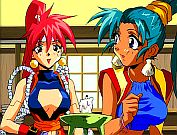
In this sequel to Saber Marionette J, Otaru and the marionettes, Lime, Cherry and Bloodberry, take care of some unfinished business from the first series and unexpectedly acquires some new marionette "students" that wish to fully realize their potential to be human. Dealing with a houseful of lively women, Otaru learns a few new things himself about being human. As catastrophe looms over the planet of Terra II, the marionettes find that a human heart carries a heavy price: it can be broken. (6 episode OAV series, from Bandai, US VHS and DVD release by Bandai.)
[Entry by Karl Merris]
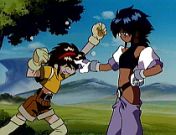
This OAV feature was released prior to Saber Marionette J, but is set three centuries after that series. A young boy, Junior, heir apparent to the throne of the city-state of Romana, is hunted by his mad brother and his army of warrior marionettes. The boy's only hope for survival lies with three marionettes, Lime, Cherry and Bloodberry, who are dedicated to Junior's defense. There's plenty of action and surprising revelations as Junior struggles against his brother to determine the fate of Terra II. (3 episode OAV series, from Bandai, US VHS release by Bandai, US DVD release by Anime Works.)
[Entry by Karl Merris]
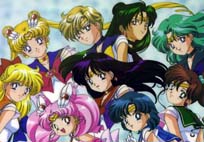
The first of the "mahoshoujo sentai" genre, taking inspiration equally from the "magical girl" and "fighter team" genres, Sailor Moon is about a team of (mostly junior-high-school) girls who are reincarnated from the Silver Millenium (a time of magic), reborn to protect Earth from a series of evil invaders.
This show is more suitable for adults than others in the genre; while it offers the standard transformation sequences and monsters of the week, it also has a strong sense of humour that frequently approaches parody, and presents a more interesting cast of characters than many such shows. The US dub of the first two seasons cuts much of the subtext that makes the show worth watching, and makes major changes to some characters' personalities; in particular, the heroine is presented in a much less positive light. Despite that, the airing of Sailor Moon on North American television started the latest cycle of popular-culture awareness of anime.
ADV released edited-for-television dubs and uncut subs of the first two seasons, while Geneon released uncut bilingual versions of the third and fourth seasons and all three Sailor Moon movies - these are no longer available commercially. The fifth season was never licenced in North America.
[Entry by David Damerell, Scott Delahunt, and Rob Kelk]
During the day, she is Haneoka Meimi, at St. Paulia school, but when there is a need, during the night she turns into the Magical Girl Saint Tail, with the help of her friend and classmate Seira, who is a nun in training and is the only person that knows the identity of Saint Tail. Help to steal precious objects, but with the objective to return them to their rightful owners after being stolen by unscrupulous persons. Saint Tail is chased by Daiki Asuka (Asuka Jr.) who has the mission to catch and discover the real identity of Saint Tail, and also is Meimi's classmate. As part of a private deal between Saint Tail and Asuka Jr., she must tell the young detective when her next attack will occur.
Saint Tail is not the normal magical girl, since must of her tricks evolve between illusionism and magician tricks, many of them taken from her father's skills as a professional magician, but is a nice and fun show, with character development and cute romantic moments.
Saint Tail comprises 43 episodes and are available on DVD from TokyoPop.
[Entry by Gerardo Campos]

The end of the Edo Jidai as you've never seen or heard it before. Two young master swordsmen - one a drop out from a prestigious dojo and the other a former pirate - become unwilling and unlikely guardians to a teen-aged waitress who wants to find a mysterious samurai who "smells like sunflowers". As the three strangers travel across Japan and slowly become friends the audience is treated to a brilliant collage of action, visual poetry, side-splitting humor and an occasional slice of powerful human drama. If you liked Cowboy Bebop you'll love Samurai Champloo.
Licenced by Geneon in North America, and by Madman in Australia.
[Entry by Dave Baranyi]
see Rurouni Kenshin
see 3×3 Eyes
Pacifica Casull is the "Scrapped Princess" prophesied to destroy the world on her 16th birthday. Thus she travels the world with the protection of her adopted siblings, the droll swordsman Shannon and the ditzy mage Raquel, fending off those who seek to kill her. However, it seems as though the prophecy may be only partly true, but there are forces that really don't want the truth revealed.
One of the better recent fantasy anime, Scrapped Princess features the usual high standards of production one comes to expect from Studio Bones (RahXephon, Angelic Layer). The vast cast of characters are generally seen as the strong point of the show, with most getting at least a modicum of decent development - however, Pacifica herself has a tendency towards irritating brattishness, and the writing itself is occasionally rather clunky, with a central plot twist you can see coming a mile away that's been slightly overused as of late. Yet while Scrapped Princess is hardly revolutionary or massively deep, it's great fun to watch and simply enjoy - what more could you want?
Scrapped Princess is licensed by Bandai, and begins its DVD release in April 2005 in Region 1.
[Entry by Andrew Hollingbury]
see Nadia
see Spirited Away

Lain is a shy junior-high girl living in a seemingly normal, not too very far in the future world. And yet, strange things keep happening. A classmate commits suicide by jumping off a building ... and the next day, several people receive e-mail from her. Lain's parents don't behave as you would expect. Lain starts to become interested in computers and quite naturally and easily demonstrates startling aptitude for them using them and "the wired" - the Internet of her day. But the real truth of who Lain is will be even more startling yet. A trippy, surreal, confusing and in my opinion very interesting series. Decent art and animation. Occasional gore, though very little actual violence. 13 Episodes. From Geneon Entertainment.
[Entry by Ben Cantrick]
see Keroro Gunsou
see Tenchi in Tokyo
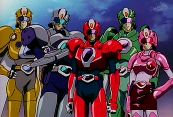
They're a team of superheroes, just like the Power Rangers, except for one little difference: Most of them don't quite understand what a "sentai" team is supposed to act like. But that's what happens when the team is corporately funded, and made up of various mid-level office workers (and an OL as the requisite token female) ...
AnimeWorks has released both OAVs on one tape. Both the sub and the dub have their strong points - the dub has some funny one-liners in the dialogue, while the sub makes it quite easy to identify the voice actors - they're given characters with the same family names.
[Entry by Rob Kelk]
see Utena
Based on the popular manga series by Kia Asamiya, Silent Möbius is set in the near future, when creatures from the dark universe of Nemesis threaten the Earth. Founded to fight this battle, the Attacked Mystification Police, a special (and all female) police department is always looking for a few good women who meet their unique requirements: each member brings her own special power (physical, cyber, religious, psychic, mystical) to the fight. These movies are really parts 1 and 2 of the same story - how AMP heroine Katsumi Liqueur came to join the force (and she's really not this whiny in the manga or TV series!).
[Entry by Jeanne Hedge]
[Was available dubbed from Streamline Pictures when Streamline was still in business. - Rob Kelk]
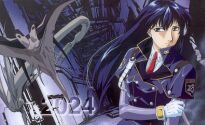
In the near future, creatures from the dark universe of Nemesis threaten the Earth. The battle has been going on for generations, and now things are coming to a head. Spanning the course of several years, Silent Möbius is a 26-episode TV series that follows the adventures of the Attacked Mystification Police, a special (and all female) police department founded to carry on where their elders left off. Each member of the force brings her own special power (physical, cyber, religious, psychic, mystical) to the fight against darkness - both from without and within. Part action-drama, part comedy, this is not a re-telling of the movies, and it's alternate-universe to both the movies and the manga series by Kia Asamiya that both TV and movies were based on (in overall tone, it's close to the manga than the movies). Available from Bandai/Anime Village.
[Entry by Jeanne Hedge]
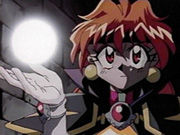
Lina Inverse, a self-proclaimed "sorcery genius" (others call her less-flattering things, like "enemy of all that live"), explores her corner of the world, rights wrongs, and gets rich (in ascending order of importance to Lina) while travelling and working with (and sometimes fighting against) an ever-changing group of companions. Lina's adventures have her going up against everything from a handful of bandits to the demon lords Shabranigdo and Gaav.
It's sometimes been said by tabletop roleplaying gamers that while Record of Lodoss War shows a stereotypical Dungeons and Dragons adventure, Slayers shows a stereotypical Dungeons and Dragons adventuring party. There's quite a bit of humour in the series, and any number of anachronisms (like Lina's bikini) and parody characters (like Amelia Wil Tesla Sailoon, the Sailor Moon wannabe) show up in the course of three television series, two OAV series, and five movies.
The three television series (Slayers, Slayers Next, and Slayers Try) are available in North America from Software Sculptors, while the OAVs and movies are available in North America from ADV Films.
[Entry by Rob Kelk]
Sol Bianca centers around the five woman crew of a pirate ship of the same name. There are two OVAs, and there should have been a third. The second OVA sets up the stage for a third quite nicely, but apparently the series didn't have enough popularity to merit the third OVA. Which is a shame, because it is a very nice series. It takes place in the far flung future, where Earth is a legend, and space travel is commonplace.
In the first episode a fairly standard bit of piracy on the part of the crew of the Sol Bianca results in them accidentally capturing a boy who was stowing away on the ship they'd plundered. Events cause them to take on an entire planetary empire, and show that in addition to looking very nice the Sol Bianca has a range of rather astonishing powers (including the mandatory BFG).
The second episode explains more about the ship, and why it has such extraordinary powers. Unfortunately the explanations are mostly in the form of rather obscure hints, and this sets up quite nicely for the third episode, which doesn't exist.
Excellent mecha design, an intriguing cast, and well done animation and pacing.
The first OVA is available from ADV on VHS in both sub and dubbed format. The second OVA is available from ADV on VHS in subtitled format only. The OVAs are not available on DVD.
[Entry by Brad Jackson]
This series shares the ship design, most of the character designs, and many of the character personalities with the first two OVAs, but it is neither a sequel nor a prequel. In the same tradition as the various incarnations of the Tenchi Muyo universe, we see a different, and in many ways better, version of Sol Bianca.
The ship design is mostly the same, and those few changes that exist are all improvements. The character designs are improved, and the characters have deeper and more complex personalities than they do in their first incarnations. Jun is still the data hack, but Feb is no longer the captain; that job has passed to April. May's character is the most changed, instead of being a short mecha freak, she is now a child.
The computer-generated scenes are okay, but not really worth raving about. Generally though the animation is much better than it was in the first OVAs, and the first OVAs had very good animation. The storyline is engaging, and the characters make you care about them. The quality of the dub, like many of Geneon's other late-1990's releases, is surprisingly good. Not Disney quality, but it's actually enjoyable even to subtitle fans.
There are six episodes to the new Sol Bianca OVAs.
Sol Bianca: The Legacy is available from Geneon.
[Entry by Brad Jackson]
A very understated, sweet and heartwarming alternate world fantasy about a 17 year old girl named Yume who leaves her quiet Country life to go to the Big City (Tokyo) to learn to become a professional mage. This is a world that is much like our own, only in which magic is real and can be performed by a few special people. Yume is one of those special people and Someday's Dreamers tells of Yume's discovery of the true meaning of her powers. The detailed backgrounds of Tokyo in the summer add to the overall sense of "reality" to the story and the characters and their stories charm the audience from beginning to end.
[Entry by Dave Baranyi]

Carrot Glaice, Tira Misu and Chocolate Misu are the Sorcerer Hunters, a group commissioned by the goddess "Big Mama" to hunt down renegade sorcerers. These three particular people are chosen for their mix of talents. Carrot, in particular, is highly qualified for reasons I can't tell you without spoiling a major plot point. However, he's also an amazing letch, so his two companions have to keep him in line, by tying him up in their sexy outfits, if need be! This is a TV series, and so the artwork and animation could be better, though they're not terrible - just not great. Mostly this is just fun, stupid fluff. Has sexual overtones and occasional violence. Dub and sub. 25 episodes. From ADV Films.
[Entry by Ben Cantrick]
A near-future sci-fi anime from Gonzo, Speed Grapher is at times lurid, perverted, nihilistic, gory and vulgar, but that's all part of its deliberate "charm". What we have here is a "chase, capture, escape" action thriller that has been given the sort of glossy superficial trashiness that we haven't seen much of since sci-fi magazines of the 70's, while at the same time the story is, at its heart, an odd mix of romance, lust and longing.
Tatsumi Saiga, a famous but now burned-out war photographer who has recently recovered from near fatal wounds from his last assignment, stumbles upon a true "den of iniquities" in Tokyo where the rich and powerful in Japan get to taste the most forbidden of pleasures, and if they are chosen, get to have their innermost dreams made real by a kiss from a "goddess". Saiga unintentionally gets kissed by the young "goddess", who tearfully asks Saiga to save her. That kiss changes Saiga into a "Euphoria", a monstrous being whose innermost wish has now turned into a terrible reality. In Saiga's case, his "wish come true" means that now when he "shoots a photo", his camera truly "shoots" the target with varying amounts of destructive power.
Saiga is not the only person to have been transformed into the "Euphoria" state. There are many others out there who now have unimaginable powers of cruelty and destruction and they are sent after Saiga after he becomes obsessed with answering the plea for help from Kagura, the young "goddess", who is the powerless pawn of her fabulously wealthy and powerful mother Shinsen and her mother's right-hand-man and lover Suitenguu. Add to this set-up a slew of baroquely conceived characters, animation that occasionally approaches a dreamlike quality, and a jazzy sound track and you have a dark and sometimes subtly humorous bit of fast-action brain candy that doesn't take itself too seriously and is consistently entertaining. Never-the-less, Speed Grapher is not for all tastes and this is a case where "viewer discretion" is definitely advised.
[Entry by Dave Baranyi]
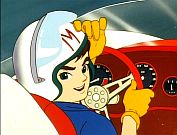
Based on the 1966 manga Mach Go Go Go, this 52 episode 1967 series by Tatsunako studios shows the career of Speed Racer (Go Mifune) from beginner racer to world champion. The dub version is noted for its mixture of interesting storylines and unintentionally campy dialog and numerous bad puns in regards to character names.
It was considered popular enough that in the 1990s two revival attempts were tried: one in America under the title New Speed Racer (1993) [13 episodes] and the other in Japan by Tatsunako studios under the title Mach Go Go Go (1996) (aka Y2K Speed Racer) [52 episodes were planned, only 34 made]. Neither revival worked partly IMHO due to the stories not measuring up to the original.
In North America, Geneon put out a DVD called Speed Racer Movie which contained "Car Hater", the two part "Mammoth Car" and a commentary; Speed Racer Enterprises released limited edition (1000 copies) VHS and DVD sets. FHE is putting out a limited edition DVD set at the rate of one volume a year with 11 or 12 episodes per volume; at this rate, the set should be complete in 2006. In Australia, Siren releases Speed Racer.
[Entry by Bruce Grubb]
see Sorcerer Hunters
Once upon a time, a girl named Chihiro and her parents were driving to the father's new job in a new city when they stopped to explore a strange tunnel. This tunnel lead to the spirit world, where Chihiro's parents were turned into pigs and Chihiro had to work at a bathhouse while she looked for a way to turn her parents back into people. Chihiro met a lot of strange people while she worked at the bathhouse, and learned a lot about herself at the same time ...
This may be the closest that Hayao Miyazaki has come to telling a European-style "fairy tale", although there are more than enough Japanese elements in the story to make it strange to western eyes. Other than the parents' transformation sequence, there is nothing in this story that a young child would find frightening, although there are a few things that may start them asking questions that some parents aren't ready to answer. As always, please preview this movie before letting your children watch it.
Available from Disney.
[Entry by Rob Kelk]
See Gundam
The space warship Amaterasu returns home from its shakedown cruise only to discover that its home planet has been invaded by, and surrendered to, a vastly superior force. The officers abandon ship, but the cadets who were on board use a legal loophole to take possession of the Amaterasu and continue the war against their foe. The only problem is that they have no way to re-supply ... until they sign a deal giving a television network exclusive rights to broadcast their battles.
In the hands of a lesser writer, this could have become a bad parody of reality shows in space. But Starship Operators was written by Ryo Mizuno (Record of Lodoss War), and he turned this premise into an exploration of doing what you think is right even when everyone else has abandoned you, the role of embedded journalists in wartime, the packaging of news as entertainment, the self-serving concerns of some people in high political office, and, above all, the importance of choosing your allies carefully. And he does all this around and within the action-packed space battles people have come to expect in a space opera.
Thirteen episodes, released in North America on three DVDs by Geneon.
[Entry by Rob Kelk]

On a dare, a boy priest named Nakahito enters a "haunted" house, surrounded by the military, in 1920's Japan. He knocks over what looks like a female mannequin, which falls on him and "kisses" him by accident. This kiss awakens the second generation prototype battle droid Steel Angel Kurumi (a bold, pink-haired, upfront "girl"), who bonds with her new master, Nakahito. The madly-in-love Kurumi refuses to obey orders from her creator or the military, and easily defeats their attempt to capture her.
Faced with this, they decide to forcibly activate the second prototype, Saki, and send her to retrieve Kurumi. After a fierce battle between the two prototypes, Saki's energy runs out and she goes dormant. After a little thought, Nakahito and Kurumi realize that Kurumi was activated by the kiss and its decided to active Saki the same way, but a suddenly jealous Kurumi pushes Nakahito aside and kisses Saki herself. Saki (an average sized brown-haired "girl") bonds to her new master Kurumi, but her lesbian love is frustrated by Kurumi's love of Nakahito. She decides to make Kurumi happy by obeying Nakahito, and the two never realize who Saki's real master is.
After a few first generation Steel Angels fail to capture Kurumi and Saki, Karinka, a new experimental model with a double "heart", is sent to capture them. Karinka (a petite blonde flat-chested loli-droid) battles both prototypes, eventually joins them, and even steals a kiss from Nakahito. Frustrated by their failures, the secret organization who is behind the battle droids activates their ultimate Steel Angel for a final battle.
Currently available in North America as a seven-DVD set from ADV, Steel Angel Kurumi Complete Collection, that includes the original series, a four-episode OVA series, and an inferior second series.
Parental Advisory: Brief partial nudity (fully exposed breasts).
[Entry by Rob Maxwell]
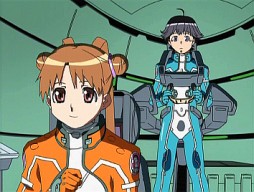
Two centuries after the first wave of a supernova explosion passed through the Sol system and killed a large fraction of humanity, many of the descendents of the survivors are in space, ready and waiting for the explosion's second wave to arrive. This is the backdrop for a new high-school class' arrival at the space station "Stellvia".
Shina Katase, already an exceptional computer programmer at age 16, is one of Stellvia's new students. But she's not at school to learn how to program - she wants to be a pilot and see the universe with her own eyes. When the "Second Wave" finally reaches Earth, a few months into the first semester, and the operation to save the lives of everyone still on Earth goes wrong, Shina and her classmates are the only ones available to make things right... and then the real problems emerge.
Stellvia is possibly unique in being a shojo space opera. The science, while being correct in almost every particular, takes a back seat to the relationships and romances between the students (and between a few of the teachers). The main characters, and most of the secondary characters, have complex personalities; there are no stereotypes in the cast. And while there are plenty of situations where the characters have to act or risk everything, the consequences of those actions are not sugar-coated.
Parental Advisory: There are a few violent scenes - while death is not shown on-screen, it is an important element of one part of the story. Also, the characters have a more accepting attitude towards some sexual preferences than many modern-day cultures do (while nothing is spelled out, Hints Are Dropped).
Available in R1 from Geneon.
[Entry by Rob Kelk]
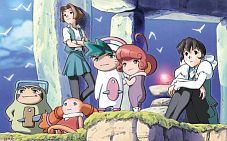
Strange Dawn is an intriguingly naturalistic take of what happens when you drop two ordinary 16 year old girls into a parallel world populated by constantly warring tribes of knee-high people who hail them as superheroes: Where are the toilets? Oh no, we don't have any clean clothes! Do we really want to be saviours, or should we just keep our heads down and look for a way home? The attention to everyday concerns may sound comical but actually it makes the whole thing believable, and heightens the impact of the violence which punctuates the tale as rival factions fight over the girls. The story is complex and mysterious: every character has their own agenda, and neither we nor the girls really know what's going on, and in their case they are not sure they even want to know.
The series is 13 episodes long, and a nicely blended mix of cel and CGI. The DVD version is both sub & dub. The dub has a mixed Anglo-Australian-European sound to it which non-American viewers find refreshing, but many American viewers can't bear. The voice acting is good and in keeping with the tone of the original; however the translation itself is a salutary reminder of the ambiguities of the Japanese language: where it's possible to translate a sentence in two different ways, the dub infallibly picks the wrong one. This just adds to the overall air of mystery though, so the dub is undoubtedly destined to be a cult classic, especially when you throw in the complete absence of lip sync.
Partially released in North America by Urban Vision.
[Entry by Shez]
Classic-style magic girl shoujo anime returns in a big way with the 51-episode Studio Pierrot/TV Tokyo adaptation of Moyoco Anno's Sugar Sugar Rune. This bright, lively and entertaining series combines everything that you want in mahou shoujo anime; magic, mystery, cute outfits, comic sidekicks, pretty girls and plenty of bishiis, along with comedy, romance and drama. The animation ranges from good to occasionally surprisingly excellent, the voice acting is spot-on, the direction is crisp and the story builds towards and delivers a self-consistent and satisfying conclusion.
Witch People from the Magical Realm in a parallel world regularly come to Earth to "capture hearts" from unaware humans. These crystalline "hearts" are the embodiments of the emotions of a human. Crystal hearts that contain the various ranges of love are most valued, but even hearts containing negative emotions have power. Two young witches, Chocola and Vanilla, are sent to Earth on a special mission; they must compete against each other for crystal hearts, and the eventual winner will become the future Queen of the Magical Realm. Chocola and Vanilla are enrolled in a private middle school on Earth and are under the care of an adult and powerful Mage, Robin, who covers his actions on Earth under the guise of being a rock star.
Chocola and Vanilla have been friends since early childhood, although their backgrounds are different. Chocola is an orphan who was raised by her eccentric grandfather. Vanilla is the daughter of the current Queen of the Magical Realm. Chocola is brash, outgoing and a bit tomboyish, characteristics that make her very popular in the Magical Realm. Vanilla is shy, unsure of herself and quiet. Once on Earth, Vanilla's character makes her an immediate hit with all the boys around her, allowing her to easily acquire crystal hearts. But Chocola's personality has the opposite effect, reducing her ability to compete with the cute and very feminine Vanilla.
But many things are going on in the background, unbeknownst to the two young Queen Candidates. The Magical Realm is threatened by a force from the past that is bent upon revenge, and even the two girls on Earth can't escape from the threat from the Dark Realm. In particular, Chocola is drawn towards the mysterious and enigmatic older boy Pierre, who is not only immune to Chocola's magic charms, but appears to have some dark secrets of his own.
All-in-all, Sugar Sugar Rune delivers a very enjoyable story with memorable characters that is suitable for mahou shoujo fans of all ages.
[Entry by Dave Baranyi]
A very nice production of two OVAs where a deliquent girl is persuaded by the threat of Death Penalty for her murderous mother to pose as a student at her old high school and figure out who is responsible for the deaths of two bus loads of students.
Strong character in the heroine, Saki the YoYo, with her police-supplied Super Yoyo. I wonder why it never went on to a series but most likely the police weren't happy as one is depicted as corrupt.
It is lurid with loads of violence. I saw the KOR production inspired by this which is why I decided to watch it.
100 minutes Hybrid DVD; ADV Films.
[Entry by bobbie sellers]

To slightly misquote the old Cyndi Lauper song, "Gals just wanna have fun!" Ran Kotobuki is a typical slacker student - barely passing at school and not caring about it - who lives for the after-school experience of shopping and dating. But Ran has a mean left hook and a strong moral streak (her parents and brother are all police officers), which leads her to stand up to injustice when it isn't inconvenient or when it really offends her sensibilities. Ran spends most of the series hanging out in Shibuya with her best friend Miyu (who is in love with Ran's brother), their formerly-studious classmate Aya, and some others who it would spoil the plotline to name here ...
This is a good corrective to all the anime that are filled with model students (such as Azumanga Daioh and Card Captor Sakura); it shows that there are Japanese students who just get by in class and get into trouble with their teachers, too. While the tone of Super GALS! is sometimes serious, it's primarily about having fun, living life to the fullest even when you've already spent all of your allowance, and being true to your friends and your favourite place to hang out.
The first 26 episodes of Super GALS! have been released in North America by ADV; the remainder of the series has been released in North America by Right Stuf.
[Entry by Rob Kelk]
see Maris the Chojo